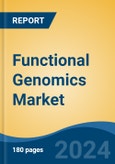Kits & Assays is the fastest growing segment, North America is the largest regional market
Speak directly to the analyst to clarify any post sales queries you may have.
10% Free customizationThis report comes with 10% free customization, enabling you to add data that meets your specific business needs.
Key Market Drivers
The Global Functional Genomics Market is significantly influenced by ongoing technological advancements in genomic sequencing, which continuously enhance the efficiency and accessibility of genetic analysis. Breakthroughs in sequencing platforms have dramatically reduced the cost and increased the speed of generating genomic data, enabling researchers to conduct studies at an unprecedented scale.For instance, according to *Next-Generation Sequencing Costs: The Sub $100 Genome*, in September 2024, Complete Genomics released the DNBSEQ-T20x2 sequencing platform, capable of producing 50,000 whole genome sequences per year for less than $100 per 30x human genome. This reduction makes population-scale functional genomics projects more feasible, fostering a deeper understanding of gene function in health and disease and driving the discovery of new therapeutic targets and biomarkers. The increased throughput allows for more extensive experimental designs, moving beyond single-gene studies to comprehensive functional analyses across entire genomes or transcriptomes.
Key Market Challenges
A significant challenge impeding the growth of the Global Functional Genomics Market is the substantial initial investment and ongoing operational costs associated with its specialized technologies and required expertise. These financial demands directly limit market adoption, particularly among smaller research institutions and emerging biotechnology firms. Such entities frequently lack the extensive capital resources necessary to acquire high-throughput sequencing platforms, establish robust bioinformatics infrastructure, and recruit skilled personnel essential for functional genomics research. This financial barrier restricts overall market expansion by reducing the number of active participants and the volume of genomic studies undertaken globally.Key Market Trends
The integration of Artificial Intelligence and Machine Learning for genomic analysis represents a significant trend in the Global Functional Genomics Market, transforming how complex biological data is interpreted and utilized. These technologies enhance the precision and speed of identifying gene functions, understanding disease mechanisms, and discovering therapeutic targets by processing vast datasets that would be unmanageable through traditional methods. According to a Pistoia Alliance survey conducted in October 2025, 77% of life sciences laboratories anticipate using AI within the next two years, with AI remaining the top investment area for 63% of respondents for the third consecutive year. This demonstrates a strong industry commitment to leveraging AI for advanced genomic insights.Key Market Players Profiled:
- Agilent Technologies, Inc.
- Becton, Dickinson and Company
- Bio-Rad Laboratories, Inc.
- Danaher Corporation (Integrated DNA Technologies, Inc.)
- F. Hoffmann-La Roche Ltd.
- Illumina, Inc.
- MRM Proteomics Inc
- Perkin Elmer, Inc.
- QIAGEN N.V.
- ¬¬¬Thermo Fisher Scientific, Inc.
Report Scope:
In this report, the Global Functional Genomics Market has been segmented into the following categories:By Product:
- Kits & Assays
- Instruments
By Technology:
- Next-Generation Sequencing (NGS)
- Polymerase Chain Reaction (PCR)
- Microarray
- Other Technologies
By Application:
- Epigenomics
- Transcriptomics
- Proteomics
- Metabolomics
By End-User:
- Academic and Research Institutions
- Biotechnology and Biopharmaceutical Companies
- Others
By Region:
- North America
- Europe
- Asia-Pacific
- South America
- Middle East & Africa
Competitive Landscape
Company Profiles: Detailed analysis of the major companies present in the Global Functional Genomics Market.Available Customizations:
With the given market data, the publisher offers customizations according to a company's specific needs. The following customization options are available for the report.Company Information
- Detailed analysis and profiling of additional market players (up to five).
This product will be delivered within 1-3 business days.
Table of Contents
Companies Mentioned
The companies profiled in this Functional Genomics market report include:- Agilent Technologies, Inc.
- Becton, Dickinson and Company
- Bio-Rad Laboratories, Inc.
- Danaher Corporation (Integrated DNA Technologies, Inc.)
- F. Hoffmann-La Roche Ltd.
- Illumina, Inc.
- MRM Proteomics Inc
- Perkin Elmer, Inc.
- QIAGEN N.V.
Table Information
| Report Attribute | Details |
|---|---|
| No. of Pages | 180 |
| Published | November 2025 |
| Forecast Period | 2024 - 2030 |
| Estimated Market Value ( USD | $ 10.43 Billion |
| Forecasted Market Value ( USD | $ 17.78 Billion |
| Compound Annual Growth Rate | 9.3% |
| Regions Covered | Global |
| No. of Companies Mentioned | 10 |









